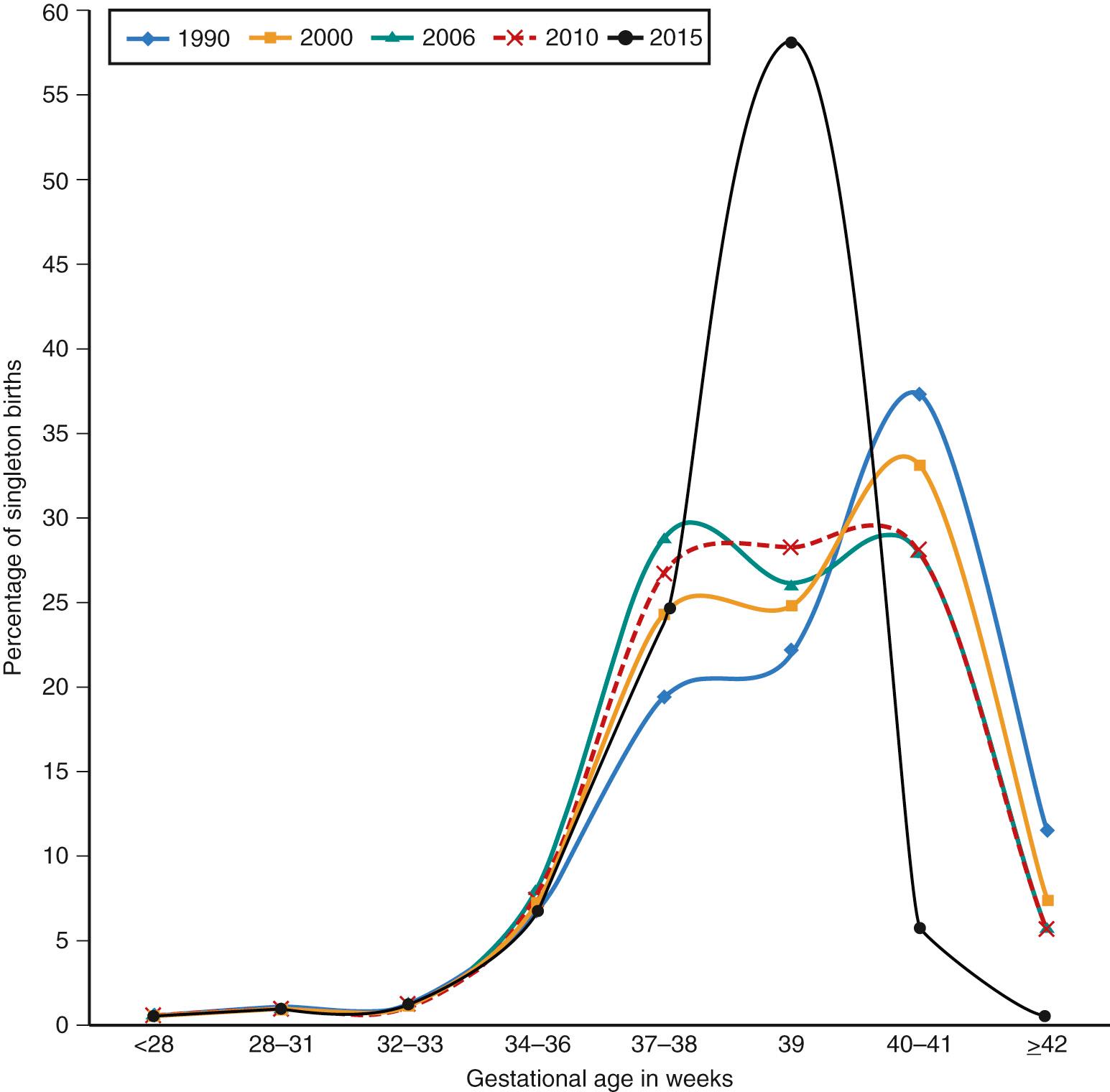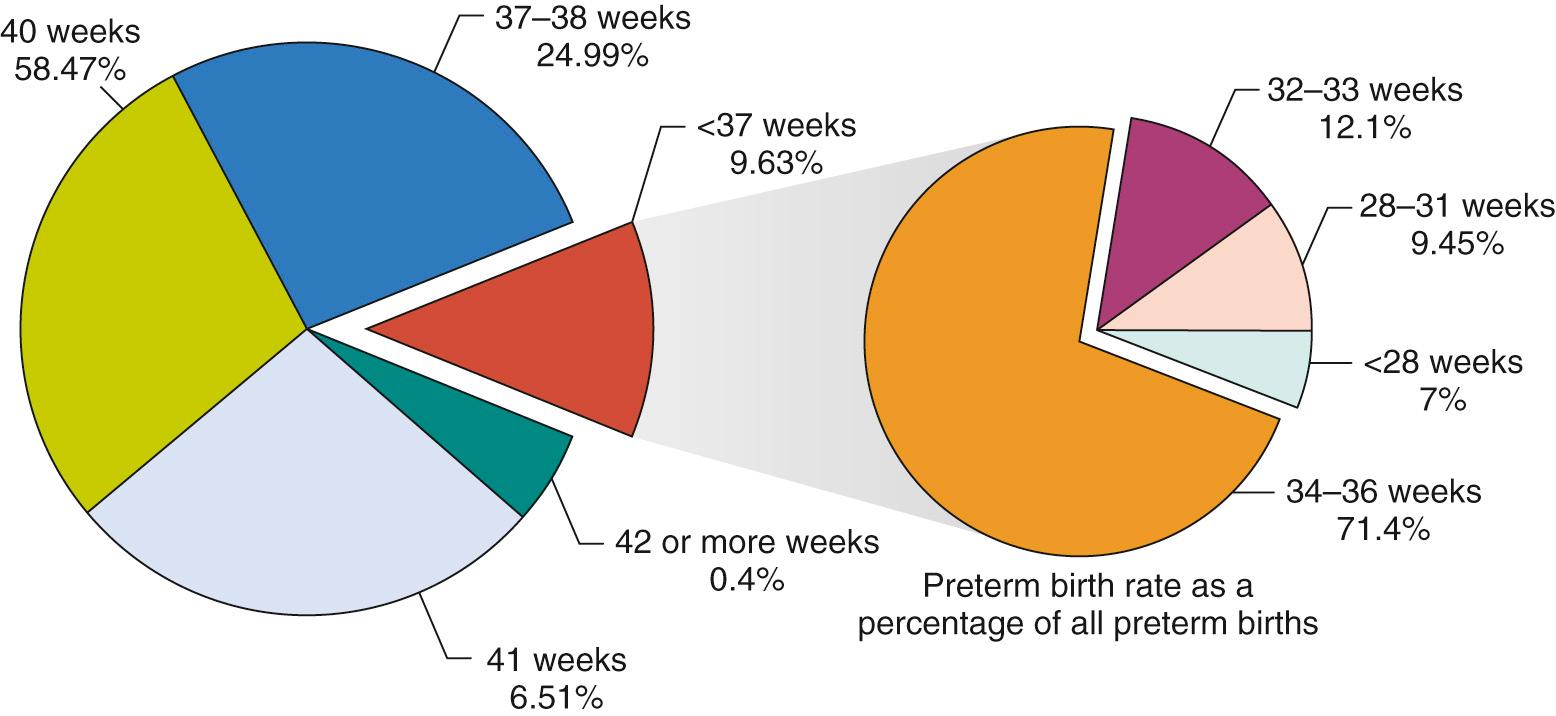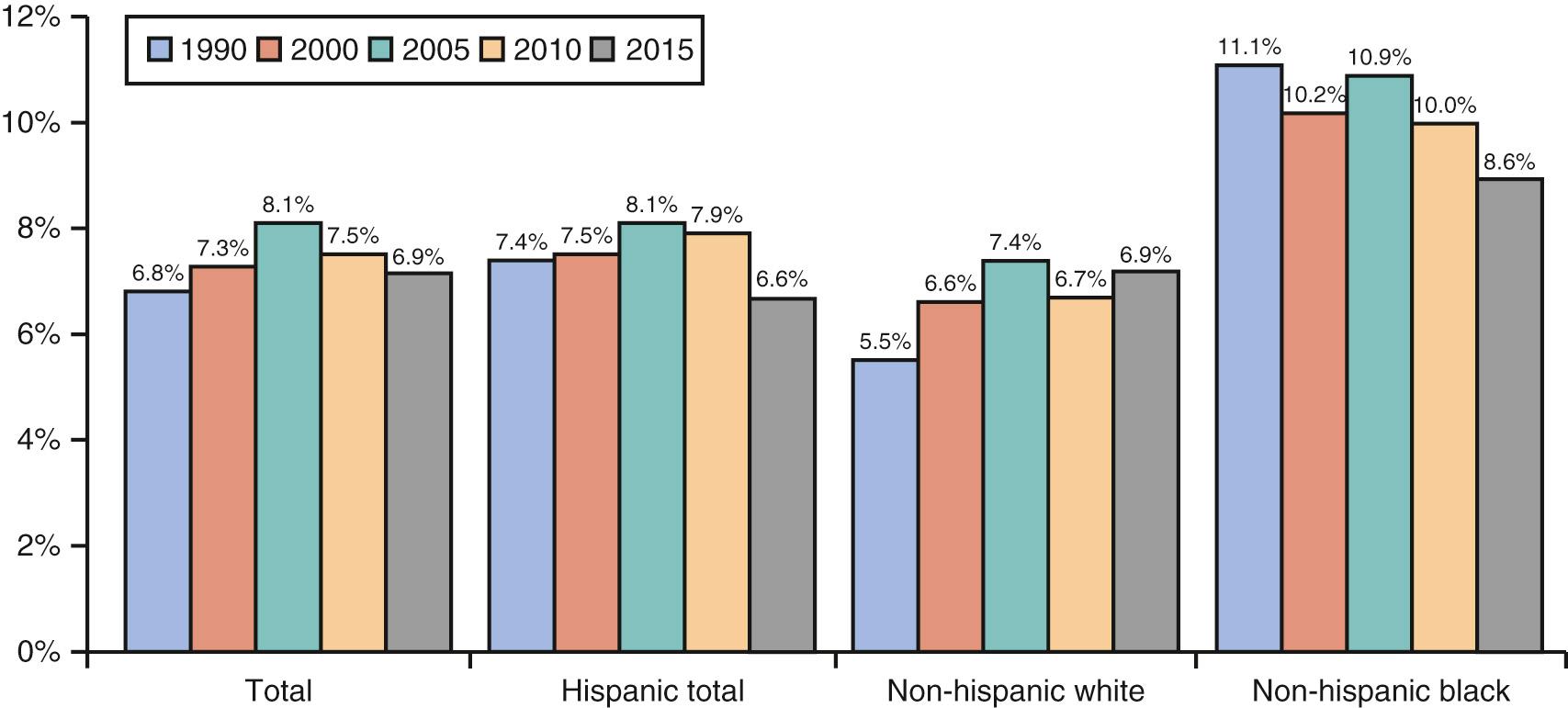Physical Address
304 North Cardinal St.
Dorchester Center, MA 02124
Births between 34 and 36 6/7 weeks’ gestation (referred to herein as late preterm births ) account for a significant proportion of preterm births in North America and elsewhere. These infants are larger than usual premature infants, and they are generally passed off as mature infants, but they often manifest signs of physiologic immaturity or delayed transition in the neonatal period. Several studies have documented the high incidence of neonatal complications leading to neonatal intensive care unit (NICU) admissions in these infants. They have a higher incidence of transient tachypnea of the newborn (TTN), respiratory distress syndrome (RDS), persistent pulmonary hypertension of the newborn (PPHN), respiratory failure, jaundice, temperature regulation problems, hypoglycemia, and feeding difficulties than term infants.
Concern about higher morbidity in late preterm infants has led to numerous publications with largely the same conclusions: Late preterm infants are more prone to problems related to delayed transition and overall immaturity, and they should be treated differently from their more mature term counterparts. These observations have led to greater attention being paid to tracking short-term morbidity, health care costs, hospital stays, and issues such as rehospitalization. Nearly three out of four preterm births occur at late preterm gestational ages, and while there has been a steady increase over the past couple of decades, we are now seeing a decline since 2007. The significant contribution of late preterm births is a worldwide phenomenon, although reported rates seem to be quite variable. The late preterm birth rate was 4.8% in Canada in 2006–2014. Danish, Finnish, Norwegian, and Swedish late preterm birth rates were 3.6%, 3.3%, 3.8%, and 3.6% respectively. In Brazil, a country known to have one of the highest preterm birth rates in the world, the first national birth survey estimated the late preterm birth rate to be 8.5% in 2011.
Preterm infants have been aptly and clearly classified for many decades. The World Health Assembly in 1948 described preterm infants as those weighing less than 2500 g or being less than 37 weeks’ gestation. In 1950, the World Health Organization revised this definition, identifying all infants born before 37 completed weeks’ gestation (259th day), counting from the first day of the last menstrual period, as preterm infants. The American Academy of Pediatrics and the American College of Obstetricians and Gynecologists (ACOG) agree with this definition.
Although preterm , term , and post-term have been clearly defined according to the week and day of gestation by the World Health Organization, American Academy of Pediatrics, and American College of Obstetrics and Gynecology, not all subgroups within the preterm gestation are well defined. There is less ambiguity about infants less than 32 weeks’ gestation in the literature, being defined as very preterm if less than 32 weeks’ gestation and extremely preterm if less than 28 weeks’ gestation, but historically no clear definition existed for infants of 32-37 weeks’ gestation. These infants were known by several different names, including moderately preterm , mildly preterm , minimally preterm , marginally preterm , and near-term . These near-term infants have been inconsistently defined in the literature as 34-36 weeks’ gestation, 35-37 weeks’ gestation, and 35-36 6/7 weeks’ gestation ( Fig. 40.1 ).

To clarify, and to place a greater emphasis on the fact that these slightly premature infants have a greater risk of morbidity and mortality than term infants, an expert panel at a workshop convened by the National Institute of Child Health and Human Development of the National Institutes of Health in July 2005 recommended that births between 34 completed weeks (34 weeks or day 239) and less than 37 completed weeks (36 6/7 weeks or day 259) of gestation be referred to as late preterm infants ( Fig. 40.2 ). Several factors led to this definition; 34 weeks is considered a maturational milestone in obstetric practice, after which surfactant is usually present in the lungs and is often used as a cutoff for giving antenatal steroids. Because there is no such thing as a normal preterm infant, and the assumptions that these infants are as healthy as term infants, use of terms such as near-term was discontinued. Data have shown that term infants born at 37 and 38 weeks’ gestation have higher morbidity and mortality than infants born at 39 weeks’ gestation. Now, infants between 37 completed weeks’ gestation (37 weeks or day 260) and 38 completed weeks’ gestation (38 6/7 weeks or day 274) are referred to as early term infants Engle and Kominiarek.

In the United States, there were 3,978,497 live births in 2015, of which 9.63%, or approximately 380,000, were preterm. Late preterm infants at 6.87% constituted 71% of all preterm births ( Fig. 40.3 ). Preterm births have steadily declined since a high of 10.44% in 2007. Increased awareness of the contribution of late preterm births to the total preterm birth rate and the increased risk to the infant lead to a significant reduction in such deliveries. This decrease may be attributed to national efforts to decrease elective or nonmedically indicated deliveries before 39 weeks’ gestation.

Non-Hispanic black infants have nearly 1.5 times the late preterm birth rate than non-Hispanic white infants. The late preterm birth rate was 8.6% for singleton non-Hispanic black infants, 6.6% for Hispanic infants, and 6.5% for non-Hispanic white infants, showing a significant decline across all races over the past few years ( Fig. 40.4 ).

Earlier studies indicated that late preterm infants have survival rates within 1% of term infants, but there is mounting evidence to show that late preterm infants have significantly higher mortality compared with term infants. Mortality rates in the 2009 period linked birth and death certificate data showing that late preterm infants have three times the mortality rate (7.13/1000 live births) compared with term infants (1.98/1000 live births), and even early term infants had higher mortality (3.09/1000 live births) compared with full-term infants.
The etiology of prematurity is complex and multifactorial, and although known clinical entities such as pre-eclampsia and premature rupture of membranes (PROM) are significant contributors to preterm births, several other causes have been implicated in the increase in the late preterm birth rate ( Box 40.1 ).
Preterm labor
PROM
Preeclampsia
Increased medical surveillance and interventions
Cesarean or planned induction of labor. Medical indications:
Abnormal presentation, abnormal placentation, maternal or fetal conditions (e.g., PROM without labor, fetal hydrocephalus)
Repeat cesarean section
Cesarean or planned induction of labor. No medical indication:
Induction of labor or cesarean section on maternal request
Fear of fetal and neonatal risks with vaginal delivery
Increased rate of stillbirths beginning at 39 weeks’ gestation
Hypoxic-ischemic encephalopathy, brachial plexus, and other birth traumas
Fear of maternal risks with vaginal delivery
Risk for genital tract, anus, and perineal injury and sexual dysfunction
Perception that cesarean delivery is “easier” and “less stressful” than vaginal delivery
Fear of the second stage and having to “push the baby out”
Maternal willingness to accept risk on behalf of the infant
Convenience for mother and family
Inaccurate gestational age assessment during elective deliveries
Maternal obesity
Presumption of fetal maturity at 34 weeks’ gestation
Decreasing gestational age criteria for inductions and increased rate of stillbirths beginning at 39 weeks’ gestation
Increase in multifetal pregnancies
Delayed childbearing and increased risk for prematurity
Use of assisted reproductive technologies (multifetal pregnancies) and increased risk for complications associated with premature delivery (e.g., preeclampsia, diabetes)
Concern for risk of adverse outcomes
Convenience
Liability
PROM, Premature rupture of membranes.
Cesarean section rates have dramatically increased in the United States and worldwide, increasing from a low of 5% in 1970 to a high of 32.9% in 2009, decreasing slightly to 32% in 2015. Among the many reasons cited for this increase are increased fetal surveillance and interventions, increased age of women giving birth, increased number of multiple births resulting from fertility treatments, obesity, and heightened concerns of physicians and mothers about the risks of vaginal birth. Although spontaneous births and births from PROM declined during this period, births from medical interventions increased, with cesarean section accounting for most of the medical intervention group. In 2006, a national consensus conference coined a new term for cesarean deliveries for which no medical indication could be found and where maternal choice was the leading factor— cesarean delivery on maternal request . Although the exact number of such deliveries is hard to track, it is believed that 2.5% of cesarean sections may be performed at maternal request.
Although elective cesarean sections are discouraged before 39 weeks’ gestation, a study by Tita and associates found that nearly 36% of elective repeat cesarean sections were performed before 39 weeks’ gestation. Among these elective cesarean births, infants born at 37 and 38 weeks had greater than 1.5 times the odds of death or complications, including respiratory compromise, hypoglycemia, sepsis, and admission to the NICU ( Table 40.1 ). Induction rates have also increased with cesarean section rates, and there was a shift toward earlier gestations in both groups. Historically, however, the induction rates for late preterm births have increased 130% since 1990. In 2012, 23.3% of all singleton live births were induced, with the rate of induction increasing 4% for late preterm births since 2006. Although medically indicated interventions have led to a decrease in the number of stillbirths, we do not know how much this has contributed to the increase in the preterm birth rate or whether the gains realized in preventing stillbirths are offset by increased NICU admissions and complications associated with prematurity. More recently, many states have implemented quality improvement programs to decrease elective deliveries before 39 weeks’ gestation. In one multistate collaborative undertaken over 12 months, elective scheduled early-term deliveries decreased from 27.8% in the first month to 4.8% in the 12th month; in addition, rates of elective scheduled singleton early-term inductions and cesarean deliveries decreased significantly.
| Outcome † | 37 Weeks | 38 Weeks | 39 Weeks | 40 Weeks |
|---|---|---|---|---|
| Any adverse outcome or death | 2.1 (1.7-2.5) | 1.5 (1.3-1.7) | Reference | 0.9 (0.7-1.1) |
| Adverse respiratory outcome | ||||
| RDS | 4.2 (2.7-6.6) | 2.1 (1.5-2.9) | Reference | 1.1 (0.6-2.0) |
| TTN | 1.8 (1.2-2.5) | 1.5 (1.2-1.9) | Reference | 0.9 (0.6-1.3) |
| RDS or TTN | 2.5 (1.9-3.3) | 1.7 (1.4-2.1) | Reference | 0.9 (0.6-1.2) |
| Admission to NICU | 2.3 (1.9-3.0) | 1.5 (1.3-1.7) | Reference | 0.8 (0.6-1.0) |
| Newborn sepsis ‡ | 2.9 (2.1-4.0) | 1.7 (1.4-2.2) | Reference | 1.0 (0.7-1.5) |
| Treated hypoglycemia | 3.3 (1.9-5.7) | 1.3 (0.8-2.0) | Reference | 1.2 (0.6-2.4) |
| Hospitalization ≥5 days | 2.7 (2.0-3.5) | 1.8 (1.5-2.2) | Reference | 1.0 (0.8-1.4) |
* Odds ratio (95% confidence interval).
† All outcomes are adjusted for maternal age (as a continuous variable), race or ethnic group, number of previous cesarean deliveries, marital status, payor, smoking status, and presence or absence of diet-controlled gestational diabetes mellitus.
‡ Newborn sepsis included suspected infections (with clinical findings suggesting infection) and proven infections.
Some studies claim that the increasing cesarean section rates stem from the changing practice standards of medical professionals and their willingness to perform cesarean sections because of the perceived safety and protection from malpractice litigation. Further prospective studies are required to quantify how much of the increase in late preterm births is owing to necessary medical interventions and how much can be attributed to cesarean section by physician or maternal request.
Gestational age measurement is an inexact science; the methods currently used, such as the Naegele rule (which assesses gestational age from the first day of the last menstrual period) and ultrasound at 20 weeks’ gestation, are accurate only to ±1-2 weeks’ gestational age. Combined with the fact that developmental variability exists during fetal maturation, and conditions such as maternal obesity and PROM can cause an overestimation or underestimation of gestational age, the task of accurate gestational age prediction is even more challenging. The ACOG more recently issued guidelines that cesarean delivery or induction on maternal request should not be performed before 39 weeks’ gestation or without evidence of lung maturity. This gradual shift toward lower gestational age along with the inaccuracies of gestational age measurement might have led to the increasing proportions of late preterm births.
Tocolysis and antenatal steroids are routinely recommended only for women at less than 34 weeks’ gestation, because infants born at 34 weeks’ gestation and beyond were believed to have mortality rates similar to that of term infants. Studies have shown, however, that infants born at 34 weeks’ gestation are at 50% increased risk for requiring intensive care, and late preterm infants have increased morbidity such as RDS, intraventricular hemorrhage (IVH), and death, and long-term morbidities such as behavioral and developmental delay. The recent ALPS (Antenatal Late Preterm Steroids) study showed significant decreases in respiratory complications in late preterm infants born to mothers who received antenatal betamethasone at 34-37 weeks. This will likely change obstetric clinical practice and outcomes for late preterm infants going forward.
Use of intrapartum fetal monitoring and prenatal ultrasound has been increasing over the years, from a rate of 68% and 48%, respectively, in 1989 to 85% and 67% in 2003. Prenatal ultrasound can lead to an overestimation of gestational age in maternal conditions associated with fetal macrosomia, such as obesity and gestational diabetes, both of which have increased rapidly in the last decade. There is the possibility of earlier intervention (induction or elective cesarean section) when ultrasound estimates are used to guide the management plan. Although fetal surveillance is designed to reduce adverse neonatal outcome, when coupled with antenatal tests with poor positive predictive value (biophysical profile, non-stress test), it may inadvertently increase medical interventions, with a resultant increase in late preterm and early term birth rates.
More women are now choosing to have children at a later age; it is well known that preterm birth is more prevalent among women with advanced maternal age. Women older than 35 years old also have nearly twice the rate of cesarean section compared with women 20-24 years old. Increasing numbers of women are also seeking assisted reproductive technologies (ART); 57,323 women delivered infants through ART in 2014, and more than 60% of these women were older than 35 years. Of infants born by ART, 32% were of multiple gestations, with 57% of twins and 98.7% of triplets or more being born prematurely. Singleton births from ART are also more likely to be preterm.
Become a Clinical Tree membership for Full access and enjoy Unlimited articles
If you are a member. Log in here